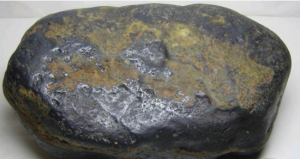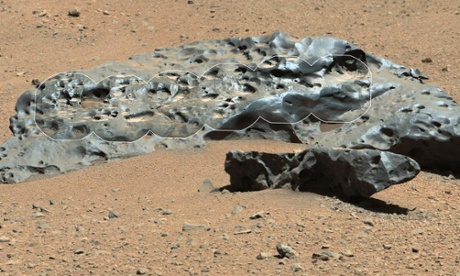Brother Guy Consolmagno, who grew up in the Detroit area, curates the Vatican's meteorite collection at the Vatican Observatory located at the pope's summer residence in Castel Gandolfo, Italy.Men of faith have always looked to the heavens.
Tonight, a metro Detroit-bred Vatican astronomer, on the roof of the pope's summer residence, Castel Gandolfo, will gaze up at the sky to contemplate God - and science.
Jesuit Brother Guy Consolmagno, a self-professed meteorite nerd, is one of 12 astronomers for the Vatican who will join stargazers around the world hoping to witness the annual Geminids meteor shower.
It's a job that's heaven-sent, said Consolmagno, who graduated from Birmingham Our Lady Queen of Martyrs grade school and University of Detroit Jesuit High School.
"Today, I would say that one of our most important missions ... is to reassure religious people that science is not a threat to their faith, but rather a great support, " Consolmagno said. "That by appreciating God's creation, we come closer to the Creator."
Consolmagno, 61, spends his time "working in the laboratory, playing with rocks that fall from outer space, giving talks around the world. I've even had a chance to go to Antarctica and look for meteorites."
"It's been a fantastic life."
He works in Italy about eight months and travels four months every year to give lectures and do research at a Vatican observatory based in Arizona.
Astronomers say the Geminid meteor showers can be the most vivid of meteor showers, with as many as 100 to 120 bright, blazing balls visible from any point on Earth. The Geminids, which continue through the middle of next week, peak tonight into Saturday morning.
Consolmagno said Jesuits have been studying the stars in the service of popes dating to the 1500s, charting the skies to help create an accurate calendar. But the Vatican also has been at war with astronomers, and Pope John Paul II apologized in 1992 for the centuries-old condemnation and imprisonment of Galileo for arguing that the Earth orbits the sun.
"Too many people with their own agendas want to build a wall between science and faith and demonize the one or the other, " Consolmagno said, "but that is bad for both science and faith."
Back in Michigan
When Consolmagno comes back to Michigan and visits longtime friends, family or Jesuits, he doesn't go looking for meteorites.
"There aren't many ... found in Michigan, " he said, "because it's hard to spot them among all the other odd rocks that the glaciers brought us."
Yet, Michigan meteorites are part of the Vatican's collection. The Vatican has four pieces of the meteorite Allegan, which fell over the western Michigan county on July 10, 1899, and four pieces of the Grand Rapids iron meteorite from 1883.
Some of the meteorites that are on display at the Cranbrook Institute of Science are on loan from the Vatican, courtesy of the onetime curious Birmingham kid who rode his bike to attend summer and weekend workshops there.
"It's my way of saying thanks for programs as a kid, " Consolmagno said of Cranbrook. "We went fossil hunting. There was a guy doing bird-tagging. Mostly, I remember the planetarium. It did everything you want a kid to do to keep him focused."
The meteorites on loan to Cranbrook include a piece of the Allegan, one from Mars that landed in north Africa, and one that landed in Germany.
Consolmagno has lectured at Cranbrook and stops in just to chat when he is in the area.
"He's an awesome guy, " said Cranbrook Institute's head astronomer, Mike Narlock. "He's incredibly personal. And he can take complex thoughts and ideas and bring them down to a basic level. He's a fantastic ambassador for both science and religion, as far as I am concerned."
'A space nut'
Consolmagno grew up the youngest of three siblings in Harper Woods and Birmingham. His dad, Joseph, was director of press relations at Chrysler. His mom, Patricia, worked as a teacher. Both live in Florida now. His brother is a musician in Marquette, and his sister is a retired grade school teacher in New Jersey.
"Sputnik went up the year I started kindergarten, and we landed on the moon when I was a senior in high school, " Consolmagno said, "so I grew up a space nut."
Just out of U-D High, Consolmagno worked at the Lapeer County Press, when its top editor was the late Free Press columnist Jim Fitzgerald. Consolmagno thought he'd become a journalist.
But after a year at Boston College, his love of science and science fiction led him to the Massachusetts Institute of Technology - "because it had the world's largest collection of science fiction" - where he received both bachelor's and master's degrees in earth and planetary sciences
He received a doctorate from the University of Arizona and returned to MIT for postdoctoral work. Tormented by thoughts that he should be doing something more meaningful than astronomy, Consolmagno joined the Peace Corps and was sent to Kenya. He was asked to teach astronomy classes in Nairobi, but he also took his telescopes to villages and delighted in rural Kenyans' reactions to seeing craters on the moon.
"These are the things that make us human, and if you deny that to someone, " Consolmagno said, "you are denying them their humanity."
After further stints as a college educator, he took vows as Jesuit brother in 1991. Consolmagno speaks Italian fluently. He learned German in high school and also has mastered Latin and Greek. He learned Swahili in the Peace Corps.
In the spotlight
Consolmagno's good-natured astronomical firepower has been featured on TV's "The Colbert Report." In 2009, he explained why the Vatican accepts the possibility of alien life. He has lunched, at their request, with William Shatner of "Star Trek" fame and the coproducer of "The Big Bang Theory, " fellow Michigan native Bill Prady. He also is the author of several books.
The Vatican's collection of meteorites comes from donations and a few items that Consolmagno has retrieved himself. He once camped for six weeks on Antarctic ice to look for meteorite remnants. It's one of the easiest places to look for meteorites because they stand out on the white surface.
Consolmagno helped welcome Pope Francis to the astronomy lab in July. He showed now-retired Pope Benedict what a sliver of a meteorite that fell near Benedict's German hometown looks like under a microscope. The late Pope John Paul II would invited the astronomers to mass.
One of Consolmagno's fondest Michigan memories is playing cards with his mom at a family cottage on Lake Huron. It wasn't who lost or won, but it was his mom's way of "telling me she loved me."
"Science is God's way of showing that he loves us. It's His way of playing with us, " Consolmagno said. "It's a way that we can engage the Creator. And every scientific puzzle is a game that He's set up. Every time I get it - I can hear Him cheering and go, 'Yeah, OK, let me show you the next one.'"
Source: www.freep.com



























